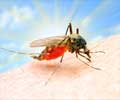A new study published in the journal Nature reveals that the actual global burden of dengue infection is more than three times the current estimates of the World Health Organization.

The study was led by Professor Simon Hay, a Wellcome Trust Senior Research Fellow at the University of Oxford, as part of the International Research Consortium on Dengue Risk Assessment, Management and Surveillance.
Dengue, also known as 'breakbone fever', is a viral infection that is transmitted between humans by mosquitoes. In some people, it causes life-threatening illness.
There are currently no licensed vaccines or specific treatments for dengue, and substantial efforts to control the mosquitoes that transmit the disease have not stopped its rapid emergence and global spread. Until now, little was known about the current distribution of the risk of dengue virus infection and its public health burden around the world.
Dr Samir Bhatt, who led the modelling for the study, says: "Our aim was to take all of the evidence that is currently available on the distribution of dengue worldwide and combine it with the latest in mapping and mathematical modelling to produce the most refined risk maps and burden estimates. We then hope to use this knowledge to help predict the future burden of the disease."
The findings reveal that dengue is ubiquitous throughout the tropics, with local spatial variations in risk influenced strongly by rainfall, temperature and urbanisation. The team estimate that there are 390 million dengue infections across the globe each year, of which 96 million reach any level of clinical or subclinical severity. This is more than triple the WHO's most recent estimates of 50-100 million infections per year.
Advertisement
"We hope that the research will initiate a wider discussion about the significant global impact of this disease."
Advertisement
Professor Jeremy Farrar, Director of the Wellcome Trust Vietnam Research Programme and Oxford University Clinical Research Unit Hospital for Tropical Diseases in Vietnam, explains that the map and estimates produced by Hay's group set the benchmark for the disease: "This is the first systematic robust estimate of the extent of dengue. The evidence that we've gathered here will help to maximise the value and cost-effectiveness of public health and clinical efforts, by indicating where limited resources can be targeted for maximum possible impact."
With endemic transmission in Asia and the Americas, recent outbreaks in Portugal, the ever-increasing incidence in Africa, and the challenges of making an effective dengue vaccine or controlling the vector, Professor Farrar stresses: "This really does represent a crucial period in the global spread of dengue."
Jimmy Whitworth, Head of International Activities at the Wellcome Trust, said: "Over time, this comprehensive map of global disease burden will also help to demonstrate which control measures are making the biggest difference in reducing the number of people suffering from dengue infection. Without a vaccine or specific treatment options, it's crucial that we understand where best to direct the limited resources available for preventing this resurgent disease."
Source-Eurekalert










